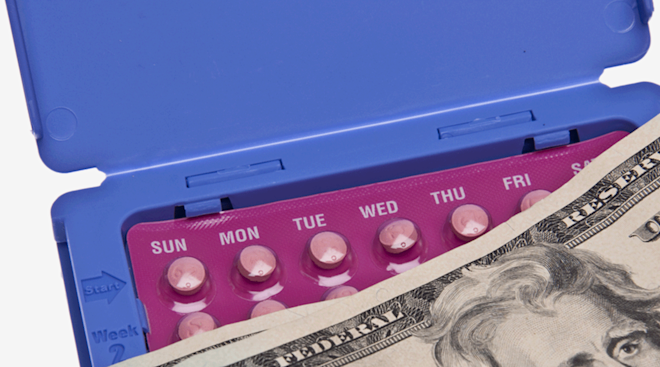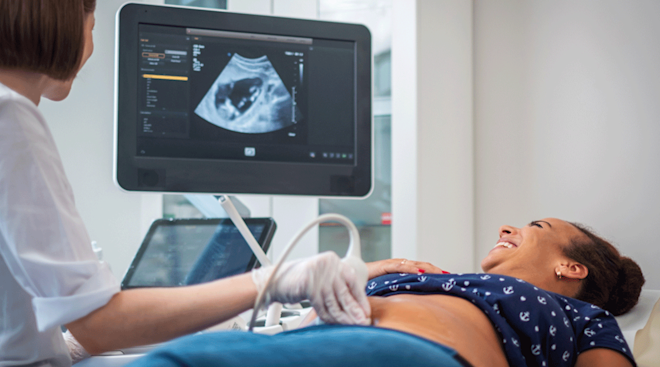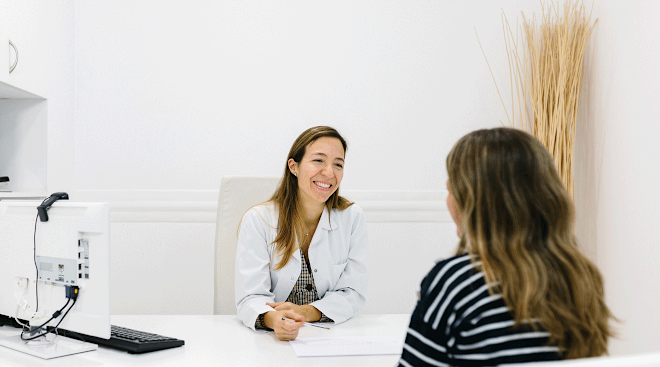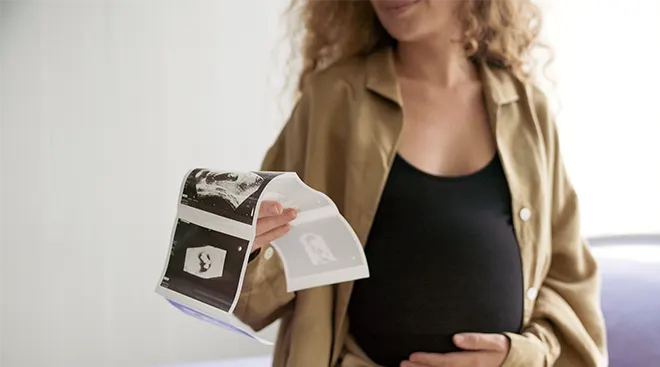What Is Chorionic Villus Sampling?
Your first trimester of pregnancy may seem like a series of nonstop tests. From that life-changing pee stick to batteries of blood tests, ultrasounds and more, keeping up with your medical to-do list can seem overwhelming. The truth is, though, many of those tests are merely diagnostic screenings. They give you an idea of how baby is doing, but they don’t tell you anything for sure.
That changes as that first trimester starts winding down—when diagnostic tests become available, should you want or need them. Among the tests? Chorionic villus sampling. Sometimes called the CVS test, it’s perhaps less recognized by non-pregnant people than the amniocentesis—but it’s just as important to have on your radar.
Chorionic villus sampling is a prenatal procedure that provides information about baby’s genetic makeup. In doing so, it helps diagnose certain chromosomal abnormalities (like Down syndrome) and genetic problems (such as cystic fibrosis).
The term chorionic villus sampling pretty much describes the process: Your doctor collects a small tissue sample of cells from the chorionic villi, tiny finger-shaped projections in the placenta that typically have the same genetic makeup as the fetus. The procedure is usually performed between weeks 10 and 13 of the pregnancy, but it’s not at all required. Typically, it’s offered to women who may be at risk for a baby with a chromosomal disorder. You might consider chorionic villus sampling if:
• You’ll be 35 or older at the time of your due date. “Every woman has a risk of having a baby with a chromosomal abnormality, but this risk increases with age,” says Ozhan Turan , MD, director of maternal fetal medicine at the University of Maryland Medical Center.
• Your doctor picked up an abnormal finding on a previous screening or ultrasound.
• You have a family history of genetic disease, chromosomal abnormalities or metabolic disorders.
What Does CVS Test For?
Once a tissue sample is gathered, it can be tested for a number of genetic conditions, such as:
- Chromosomal problems, like Down syndrome and trisomy 18
- Genetic diseases, including cystic fibrosis, Tay-Sachs disease and sickle cell disease
What chorionic villus sampling can’t do is test for neural tube defects, such as spina bifida, or heart defects or cleft lip.
The CVS test can be performed through the abdomen (transabdominal) or through the vagina (transcervical). Your visit will start with an ultrasound to determine the position of your placenta, which will help the doctor decide the method that’s best for you.
For the transabdominal CVS procedure, your stomach will be cleansed with an antiseptic and then a needle will be inserted into the uterus through the abdominal wall. Don’t worry, needle-phobes: “The needle is only slightly larger than the type that’s used to draw blood, and only a small length of it goes into your body,” says Rosemary Reiss, MD, director of the Center for Fetal Medicine and Prenatal Genetics at Brigham and Women’s Hospital in Boston. Your doctor will then use a syringe to gently collect a tissue sample, and the needle will be removed.
For a transcervical CVS, the doctor will use a speculum to open the vagina (just like during a Pap smear). Next, the vagina and cervix will be cleansed with an antiseptic, and a thin hollow tube will be inserted through your cervix until it reaches the placenta. Using gentle suction, cells will be collected into a syringe, and the tube will then be removed.
During both a transcervical and transabdominal CVS, the doctor will closely monitor the fetal position and heart rate with an ultrasound to make sure baby is safe. And it’ll all be over before you know it! The actual procedure takes a minute or two (the entire visit, about half an hour), and you can expect your test results within seven to 10 days.
Once the chorionic villus sampling is complete, you can go about your day as you normally would, though many women choose to relax and take off from work. “There’s no need to lie down, but take it easy and listen to your body,” Turan says. You may experience spotting or bleeding afterward. You might also have slight cramping, but taking an acetaminophen (like Tylenol) can help ease the discomfort. If you have a fever following CVS, or if you experience bleeding that doesn’t stop, severe cramping or fluid leakage, call your doctor immediately.
When performed correctly by an experienced health-care professional, CVS is a typically safe procedure for both mom and baby. However, some chorionic villus sampling risks do exist. These include:
• Miscarriage (the risk of a miscarriage following CVS is about 1 in 100, though some studies show a much lower risk, Reiss says)
• Rh sensitization (it’s possible for your baby’s blood cells to enter your own bloodstream during CVS; for this reason, the small percentage of women with Rh-negative blood may be given an injection following the procedure)
• Leaking of amniotic fluid
• Uterine infection
• Limb deformity (this is especially rare and typically would only occur when CVS is performed before the 10th week of pregnancy)
Chorionic villus sampling is more than 99 percent accurate when it comes to diagnosing chromosomal results, such as Down syndrome. However, there’s a sliver of a chance for a false positive—when the test comes back indicating a genetic problem, but in reality, the baby is developing normally. There’s also the very small (1 to 2 percent) possibility that the results will be inconclusive. In this case, your doctor may recommend amniocentesis (see below) to help clarify the risk of fetal genetic disorders.
Unlike with CVS, which collects cells from the placenta, an amniocentesis retrieves cells from the amniotic fluid that surrounds the baby. An amnio is usually done later in pregnancy, between weeks 15 and 20 (the risk of miscarriage goes up when an amnio is performed earlier). For women who know they won’t want to go through with the pregnancy if a genetic disorder is found, chorionic villus sampling may be the better option, since you can get the results in time to decide to terminate the pregnancy during the first trimester, when it’s safest to do so.
You may have heard that the risk of miscarriage with chorionic villus sampling is higher than with an amnio (which has been estimated to be 1 in 200). But recent research suggests this isn’t necessarily true, says Turan. One factor that affects miscarriage is the competency and experience of the health-care provider performing the CVS or amnio. A 2014 Journal of Clinical Medicine paper reports that your risks may have more to do with the competency of the facility than that general 1-in-200 stat. That said, do some research before you schedule an appointment. “I would certainly advise going to a center that does a lot of procedures, and ask if there are miscarriage figures [associated with the test] available for that center,” says Caroline Ogilvie, DPhil, professor of cytogenetics at King’s College London, and co-author of the study. If figures aren’t available, at least make sure that the provider performing the test is a qualified professional with plenty of experience in CVS.
Some expectant parents prefer not to find out if their baby has a genetic disorder—and that’s absolutely fine. But for those who do want answers as soon as possible, chorionic villus sampling can let you know with the most certainty at the earliest possible time. Not only is this helpful for parents, but it’s also an advantage for doctors: If there is an abnormality and the parents decide to continue with the pregnancy, health-care providers can plan how to safely manage the remainder of the pregnancy, should special strategies be needed.
If you’re unsure whether to undergo chorionic villus sampling, make an appointment with a genetic counselor, who can help walk you through the decision-making process. “They will take a more detailed family history than a physician would and can help explain the pros and cons,” Reiss says. If you do opt to undergo chorionic villus sampling, don’t hesitate to ask plenty of questions. Your genetic counselor is there to help you understand your risks as well as make sense of the test results.
Updated November 2017
Please note: The Bump and the materials and information it contains are not intended to, and do not constitute, medical or other health advice or diagnosis and should not be used as such. You should always consult with a qualified physician or health professional about your specific circumstances.
Navigate forward to interact with the calendar and select a date. Press the question mark key to get the keyboard shortcuts for changing dates.




















































